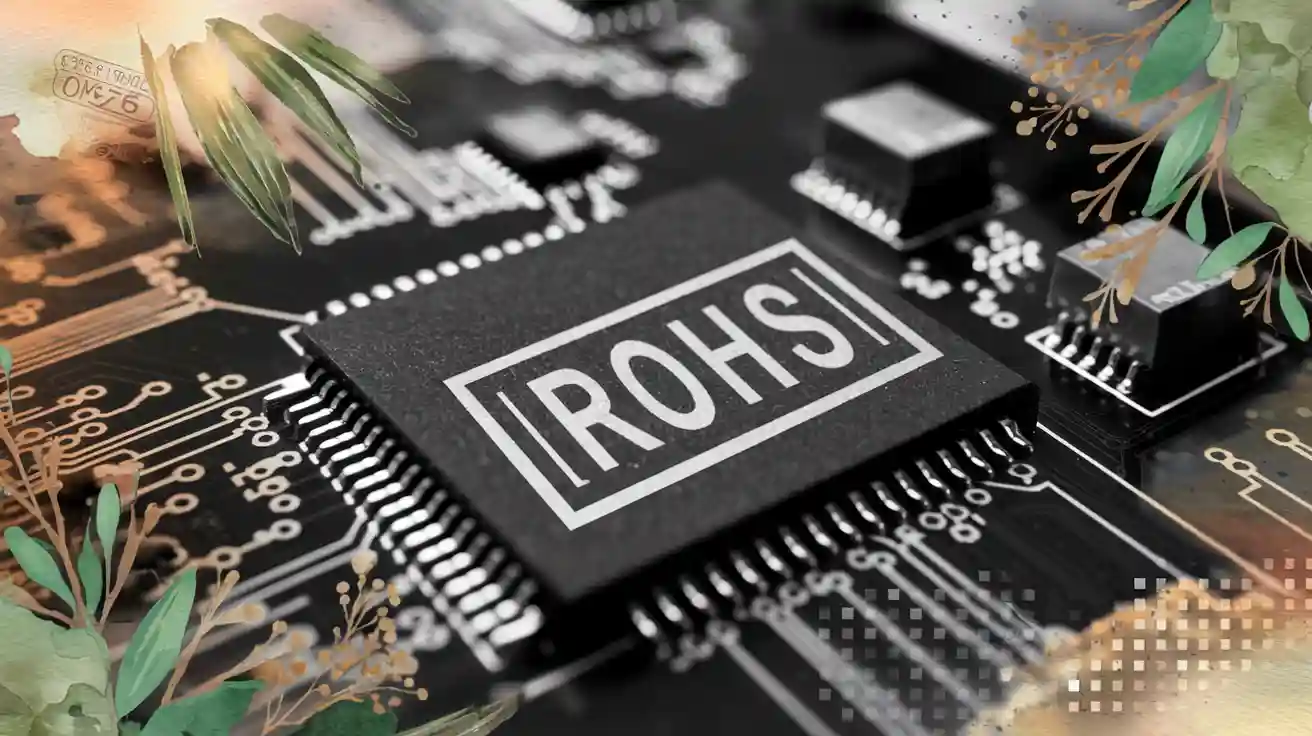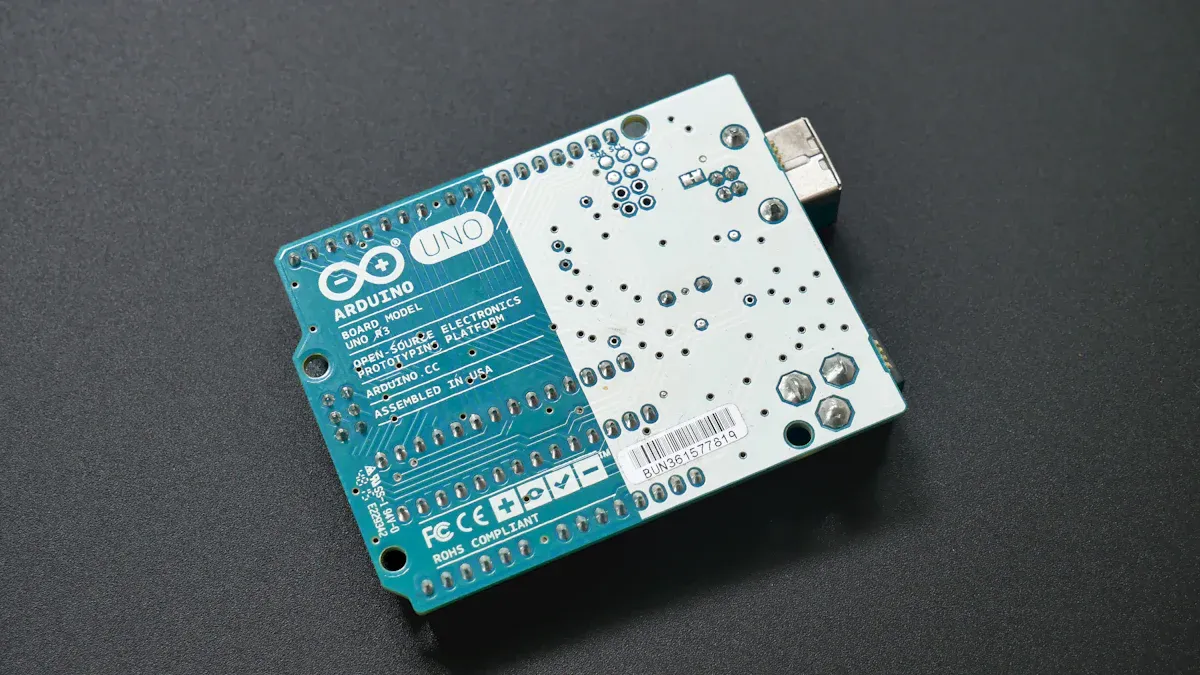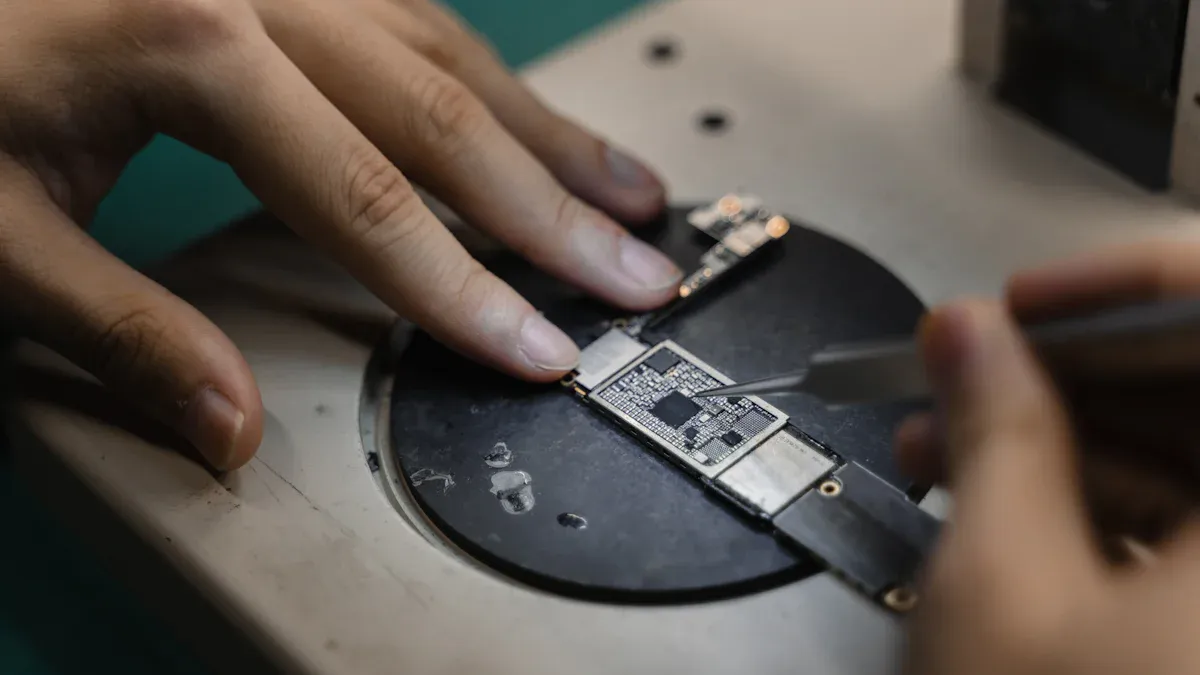The pros and cons of using RoHS-compliant PCBs in electronics
RoHS compliant PCBs in electronics prioritize environmental safety by eliminating hazardous materials like lead and mercury. You benefit from products that align with the RoHS directive, ensuring compliance with strict global standards. These RoHS compliant PCBs in electronics also enhance consumer health by reducing toxic exposure, making them safer for everyday use. However, adopting RoHS compliant PCBs in electronics can introduce challenges, such as manufacturing adjustments and material limitations. If you aim to produce electronics that meet modern expectations, these RoHS compliant PCBs in electronics offer a sustainable pathway despite the hurdles.
Key Takeaways
- RoHS PCBs help the Earth by removing harmful materials like lead and mercury. This makes the planet cleaner.
- Following RoHS rules makes it easier to sell electronics in countries with strict environmental laws.
- Using RoHS products keeps people healthier by lowering contact with toxic chemicals. This builds trust with customers.
- Making RoHS PCBs can cost more because of new materials and methods. Planning well can help control spending.
- RoHS rules support sustainability but might affect performance. Careful testing is needed to ensure products work well.
Benefits of RoHS-compliant PCBs in electronics
Environmental protection
You contribute to a cleaner planet by using RoHS-compliant PCBs in electronics. These circuit boards eliminate hazardous substances like lead, mercury, and cadmium, which are common in traditional electronics. The RoHS directive has already removed thousands of tons of toxic materials from electronic products, reducing their harmful impact on the environment. This reduction prevents these pollutants from entering landfills, where they could leach into soil and water systems.
By prioritizing green manufacturing practices, you also support sustainable development. RoHS compliance encourages the use of lead-free solder and eco-friendly materials, which align with global efforts to combat climate change. When you choose RoHS-certified products, you actively reduce the risk of metal poisoning and toxic waste accumulation, paving the way for a healthier ecosystem.
Tip: Opting for RoHS-compliant PCBs not only benefits the environment but also enhances your brand’s reputation as a responsible manufacturer.
Regulatory compliance advantages
Meeting international standards becomes easier with RoHS-compliant PCBs. The restriction of hazardous substances compliance ensures your products align with global regulations, such as those enforced by the European Union. This certification simplifies the process of exporting electronics to regions with strict environmental laws.
The benefits of RoHS compliance extend beyond legal adherence. It promotes recycling, encourages innovation, and establishes a unified safety standard across industries. The table below highlights key compliance metrics that validate the advantages of RoHS certification:
| Benefit | Description |
|---|---|
| Environmental Protection | Minimizes environmental impact by restricting hazardous substances in electronic waste. |
| Health Safety | Protects human health by reducing exposure to toxic substances for workers and consumers. |
| Promotes Recycling | Encourages design for recycling, contributing to a circular economy. |
| Standardization | Establishes a common safety standard across the EU, simplifying compliance for manufacturers. |
| Consumer Awareness | Raises awareness about hazardous materials, empowering informed consumer choices. |
| Innovation and Alternatives | Incentivizes development of safer materials and technologies, fostering industry innovation. |
| Market Competitiveness | Enhances company reputation and competitiveness by prioritizing eco-friendly products. |
| International Influence | Influences similar regulations globally, promoting standards for hazardous substance management. |
| Reduced Liability | Reduces legal liabilities and risks of recalls or fines from non-compliance. |
By adhering to RoHS standards, you avoid penalties, reduce liability risks, and gain access to markets that demand eco-friendly products. This compliance not only protects your business but also positions you as a leader in sustainable electronics manufacturing.
Enhanced consumer health and safety
RoHS-compliant PCBs prioritize consumer well-being by eliminating toxic materials from electronic devices. When you use these circuit boards, you reduce the risk of exposure to harmful substances like mercury and lead, which can cause severe health issues, including cancer and neurological damage.
The reduction of toxic materials in electronics ensures safer products for everyday use. Whether it’s a smartphone or a household appliance, RoHS certification guarantees minimal toxicity during deployment or disposal. The table below illustrates the health and safety benefits of RoHS-compliant PCBs:
| Evidence | Description |
|---|---|
| Reduction of Toxic Materials | RoHS-compliant PCBs ensure minimum toxicity when deployed or dumped, leading to improved health outcomes for consumers. |
| Health Risks of Banned Materials | Materials banned under RoHS, such as mercury, lead, and cadmium, are extremely toxic and can cause serious health issues like cancer and neurological damage. RoHS PCB assembly reduces these health risks. |
By choosing RoHS-compliant products, you protect not only your customers but also workers involved in manufacturing and assembly processes. This focus on health and safety builds trust and loyalty among consumers, further enhancing your brand’s marketability.
Improved marketability for global trade
RoHS-compliant PCBs can significantly enhance your product’s marketability in the global electronics industry. Many countries, including those in the European Union, have strict regulations regarding hazardous substances in electronic devices. By adopting RoHS-compliant PCBs, you ensure your products meet these international standards, making them eligible for sale in highly regulated markets.
This compliance gives you a competitive edge. Consumers and businesses increasingly prefer eco-friendly products. When your electronics carry RoHS certification, they signal a commitment to sustainability and safety. This can attract environmentally conscious buyers and boost your brand’s reputation.
Exporting products becomes easier when you use RoHS-compliant PCBs. Many trade barriers arise from non-compliance with environmental regulations. By meeting RoHS standards, you avoid these obstacles and expand your reach to global markets. This opens up opportunities to collaborate with international partners who prioritize sustainable practices.
Note: Highlighting the benefits of RoHS compliance in your marketing materials can further enhance your product’s appeal. It shows your dedication to quality and environmental responsibility.
RoHS compliance also encourages innovation. To meet the standards, manufacturers often develop new materials and technologies. These advancements can improve product performance and appeal, giving you an advantage in competitive markets. By investing in RoHS-compliant PCBs, you position your business as a forward-thinking leader in the electronics industry.
Challenges of RoHS-compliant circuit boards
Manufacturing complexities
Adopting RoHS-compliant circuit boards introduces significant challenges in manufacturing processes. The RoHS directive, effective since July 1, 2006, mandates the elimination of hazardous materials like lead, mercury, and cadmium. This requirement forces you to overhaul traditional manufacturing practices to meet compliance standards.
One of the most notable changes involves the shift to lead-free soldering techniques. Traditional solder, which contains lead, offers excellent reliability and ease of use. However, RoHS compliance requires alternatives like tin-silver-copper solder. These substitutes demand higher temperatures during assembly, which can strain equipment and increase energy consumption.
- Key challenges in manufacturing RoHS-compliant PCBs include:
- Eliminating hazardous materials such as lead, mercury, and cadmium.
- Adapting to lead-free soldering techniques, which require higher temperatures.
- Ensuring product reliability without established standards for new materials.
These adjustments not only complicate production but also increase the risk of defects. For example, higher soldering temperatures can damage sensitive components, leading to reduced yields. You must invest in advanced equipment and training to mitigate these risks, which adds to production costs.
Tip: Partnering with experienced suppliers can help streamline RoHS-compliant PCB manufacturing and reduce the learning curve.
Performance trade-offs
Switching to RoHS-compliant materials often results in performance trade-offs. While these materials are environmentally friendly, they may not match the reliability and durability of traditional options. For instance, lead-free solder, such as tin-silver-copper, has different mechanical properties compared to lead-based solder. This can lead to issues like brittle joints, which are more prone to cracking under stress.
- Common performance trade-offs include:
- Reduced reliability of solder joints due to brittleness.
- Higher failure rates in extreme temperature conditions.
- Increased costs for testing and quality assurance.
These trade-offs can be particularly problematic in industries like aerospace and automotive, where reliability is critical. You may need to conduct extensive testing to ensure that RoHS-compliant PCBs meet the required performance standards. This adds time and expense to the development process, making it essential to weigh the benefits of compliance against potential drawbacks.
Note: While RoHS compliance promotes sustainability, it’s crucial to evaluate how performance trade-offs might impact your specific applications.
Limited material options
RoHS-compliant PCB manufacturing limits the range of materials you can use. The directive restricts several hazardous materials commonly found in traditional electronics. These include lead, hexavalent chromium, and flame retardants like PBB and PBDE. While these restrictions protect the environment and human health, they also narrow your choices for materials that offer specific performance benefits.
| Restricted Material | Reason for Restriction |
|---|---|
| Lead (Pb) | Causes severe health issues, including nervous system damage. |
| Hexavalent Chromium (Cr(VI)) | A carcinogenic material used for corrosion resistance. |
| Mercury (Hg) | Toxic to the nervous system and absorbed through the skin. |
| Cadmium (Cd) | A carcinogen previously used in batteries. |
| Polybrominated Biphenyls (PBBs) | A flame retardant that damages the nervous system. |
| Polybrominated Diphenyl Ether (PBDE) | Used for fire retardancy but harmful to the nervous system and thyroid. |
These restrictions compel you to explore alternative materials, which may not always deliver the same level of performance or cost efficiency. For example, finding substitutes for flame retardants can be challenging, especially in applications requiring high thermal resistance. Additionally, sourcing compliant materials often involves higher costs and longer lead times, further complicating the manufacturing process.
Callout: Limited material options highlight the importance of innovation in developing new, compliant materials that balance performance and sustainability.
Increased production costs
Switching to RoHS-compliant circuit boards can significantly increase production costs. You face higher expenses due to changes in materials, processes, and equipment. These adjustments often require substantial investments, which can strain your budget.
One major cost driver is the need for new capital equipment. Manufacturing RoHS-compliant boards demands advanced machinery capable of handling lead-free soldering and higher assembly temperatures. Upgrading or replacing existing equipment adds unbudgeted expenses to your production line.
You also encounter increased inspection and testing costs. RoHS compliance requires stricter quality control measures to ensure products meet environmental standards. Receiving inspections take more than twice the time compared to traditional boards. Additionally, first-time yields often decrease, leading to more rework and longer manufacturing lead times.
- Key factors contributing to increased production costs:
- Unbudgeted capital equipment upgrades
- Extended inspection times
- Reduced first-time yield rates
- Higher rework rates
- Longer lead times
Procurement costs also rise when sourcing compliant materials. Locating RoHS-compliant parts can be challenging, especially as leaded components become obsolete. Engineers often receive multiple notifications daily about discontinued parts, forcing you to spend more time and resources on procurement.
Military-qualified products add another layer of complexity. Transitioning to 100% environmental stress screening (ESS) for these products increases costs further. This process ensures reliability but requires additional testing and specialized equipment.
Tip: To manage costs effectively, consider partnering with suppliers who specialize in RoHS-compliant components. Their expertise can streamline procurement and reduce lead times.
Despite these challenges, adopting RoHS-compliant circuit boards aligns your business with global environmental standards. While upfront costs may seem daunting, the long-term benefits of compliance—such as access to international markets and enhanced brand reputation—can outweigh the initial investment.
Practical considerations for RoHS-compliant PCBs
Cost implications for manufacturers
Switching to RoHS-compliant PCBs can significantly impact your manufacturing costs. Upgrading equipment to meet lead-free standards often requires substantial investment. For example, replacing a reflow oven can cost between $80,000 and $200,000. Mid-sized manufacturers may face total capital investments exceeding $1 million.
Material costs also rise when adopting RoHS-compliant processes. Lead-free solder alloys cost 30–50% more than traditional options. Silver prices, which surged to $24 per ounce in Q3 2023, further inflate expenses. Additionally, lead-free finishes add 8–15% to the cost of connectors and integrated circuits.
Production throughput often decreases by 12–18% due to process changes, while labor costs increase as staff hours rise by 22% to maintain output levels. Rework costs also climb by 20–30% because of defects caused by higher soldering temperatures.
| Cost Type | Details |
|---|---|
| Equipment Upgrade Costs | Upgrading a reflow oven for lead-free standards costs between $80,000 and $200,000. |
| Total Capital Investment | For mid-sized manufacturers, total investment can exceed $1 million. |
| Material Cost Increase | Lead-free solder alloys cost 30–50% more than traditional alloys. |
| Silver Price Impact | Silver prices surged to $24 per ounce in Q3 2023, inflating material costs. |
| Component Cost Increase | Lead-free finishes add 8–15% to the cost of connectors and ICs. |
| Rework Cost Increase | Rectifying defects raises rework costs by 20–30%. |
| Throughput Reduction | Production throughput can decrease by 12–18% due to process changes. |
| Labor Cost Increase | A case study showed a 22% increase in staff hours post-transition to maintain output levels. |
Tip: Partnering with suppliers who specialize in RoHS-compliant components can help you manage costs and streamline procurement.
Long-term reliability concerns
RoHS-compliant PCBs introduce uncertainties about long-term reliability. Replacement materials, such as lead-free solders, often behave differently under stress. Brittle solder joints are more prone to cracking, especially in harsh environments.
While RoHS-compliant materials meet many reliability criteria, their performance under extreme conditions remains unclear. Industries like aerospace and automotive, which demand high durability, face challenges in ensuring consistent performance. You may need to conduct extensive testing to verify reliability, adding time and expense to your production process.
Note: Understanding the mechanical behavior of new solders is crucial for applications requiring high reliability.
Industry-specific requirements
Different industries require unique adjustments to achieve RoHS compliance. For example, medical devices often undergo a bill of materials review to update components and switch from PTH to SMT assembly. This process can reduce costs by 2% per assembly.
In analytical equipment, redesigning controller boards to consolidate functions into a single processor can lower costs by 31%. Similarly, embedded process control boards benefit from eliminating obsolete components, improving efficiency, and adding functionality.
- Examples of industry-specific adjustments:
- Medical Devices: Switching from PTH to SMT assembly reduces costs by 2%.
- Analytical Equipment: Redesigning controller boards achieves a 31% cost reduction.
- Real-Time Clocks: Addressing battery life and regulatory requirements cuts costs by 52%.
- Embedded Process Control Boards: Eliminating obsolete components improves efficiency and functionality.
These adjustments not only ensure compliance but also enhance product performance and reduce costs. By tailoring your approach to industry-specific needs, you can maximize the benefits of RoHS compliance.
Adjustments in assembly processes
Switching to RoHS-compliant PCBs requires significant changes in assembly processes. These adjustments ensure that your products meet compliance standards while maintaining performance and reliability. However, the transition introduces challenges that demand careful planning and execution.
One major change involves the use of lead-free soldering techniques. Traditional lead-based solder melts at lower temperatures, making it easier to work with. Lead-free solder, such as tin-silver-copper alloys, requires higher processing temperatures. This change can strain your equipment and increase the risk of thermal damage to components. For example, higher temperatures may cause thermal fatigue or the “popcorn effect” in plastic ICs, where trapped moisture expands and damages the component.
To address these challenges, you need to adopt specialized materials and techniques. Some solder fluxes designed for lead-based solder cannot withstand the higher temperatures of lead-free soldering. You must use fluxes specifically formulated for lead-free processes. Additionally, reliability testing becomes crucial. Lead-free assemblies have different mechanical properties, so you need testing methods that match these new characteristics.
- Key adjustments in assembly processes include:
- Using lead-free solder that requires higher processing temperatures.
- Adopting specially designed fluxes for lead-free soldering.
- Conducting reliability tests tailored to Pb-free assemblies.
- Implementing measures to prevent thermal fatigue and component damage.
These changes may increase production complexity, but they are essential for compliance. By investing in the right tools and training, you can streamline your assembly processes and ensure the quality of your RoHS-compliant PCBs. This proactive approach not only helps you meet regulatory requirements but also enhances your reputation as a forward-thinking manufacturer.
RoHS-compliant PCBs in electronics play a crucial role in meeting environmental and regulatory standards. By adhering to the RoHS directive, you limit harmful substances like heavy metals and brominated flame retardants, reducing health risks for workers and communities. These circuit boards promote environmental responsibility by encouraging the use of sustainable materials and processes.
The benefits extend beyond environmental impact. Compliance ensures access to global markets, including regions with strict regulations like the EU. This positions your products competitively while maintaining high-quality production standards. However, you must weigh these advantages against challenges like increased costs and potential performance trade-offs. Careful planning helps you determine whether RoHS-compliant PCBs align with your project goals.
| Benefit | Description |
|---|---|
| Reducing Harmful Substances | Limits heavy metals and brominated flame retardants, reducing health risks for workers and communities. |
| Promoting Environmental Responsibility | Encourages the use of eco-friendly materials and practices in PCB production. |
| Access to Global Markets | Compliance is necessary for selling in major markets like the EU, providing competitive advantages. |
| Environmentally Responsible | Utilizes green materials and sustainable processes, minimizing ecological impact. |
| High-Quality Production | Maintains quality and durability while adhering to RoHS standards, ensuring functionality. |
Tip: Evaluate the long-term benefits of RoHS compliance to balance environmental responsibility with business profitability.
FAQ
1. What does RoHS stand for?
RoHS stands for “Restriction of Hazardous Substances.” It is a directive that limits the use of specific hazardous materials in electronic and electrical products, ensuring safer and more environmentally friendly manufacturing practices.
2. Are RoHS-compliant PCBs suitable for all industries?
RoHS-compliant PCBs work well for most industries, but sectors like aerospace and defense may face challenges due to reliability concerns. You should evaluate industry-specific requirements before adopting them.
3. How can RoHS compliance impact product costs?
RoHS compliance increases costs due to material changes, equipment upgrades, and additional testing. However, these costs can be offset by improved marketability and access to global markets.
4. Do RoHS-compliant PCBs affect product performance?
Yes, switching to lead-free materials can lead to performance trade-offs, such as brittle solder joints. You should conduct thorough testing to ensure reliability in demanding applications.
5. Why is RoHS compliance important for global trade?
RoHS compliance ensures your products meet international environmental standards, making them eligible for sale in regulated markets like the EU. This expands your business opportunities and boosts your brand reputation.






















